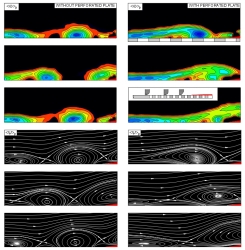You are here
Home ›Shear Flow Past a Perforated Plate: A Self-Excited Long Wavelength Instability
Shear flow past a perforated plate: a self-excited long wavelength instability. The perforated plate shown in the schematic is bounded on one side by a free stream and the other side by an enclosed, rigid cavity that precludes acoustic or elastic effects. The time-averaged shear layer shown in the schematic has the general form of a boundary layer. The phase-averaged patterns of vorticity and streamlines in the right column show formation of a well-defined concentration of vorticity and a corresponding focus and saddle point(s) of the streamline topology. These repetitive patterns are associated with sharp spectral peaks of pressure and velocity. For comparison, the oscillating shear layer in absence of a perforated plate is shown in the left column. For both cases, the corresponding spectral peaks of velocity and pressure fluctuations show remarkably similar variations with inflow velocity U and with distance L to the tip of the impingement edge. This observation indicates that the instability along the perforated plate mimics the central feature of a global instability of a convectively-amplifying disturbance in a shear layer of finite streamwise length.
Self-sustained oscillations of a free-shear flow, i.e., a jet, mixing-layer or wake, can arise from its impingement upon a downstream boundary; these oscillations are well documented. The present experiments demonstrate existence of analogous oscillations for the case of a shear layer along a perforated plate. The spectrum of the pressure fluctuation at impingement shows sharply defined peaks. Moreover, the predominant frequency of oscillation exhibits a variation with either impingement length or inflow velocity that is remarkably similar to the case of the corresponding free-shear layer in absence of the perforated plate. Quantitative imaging yields patterns of large-scale vorticity concentrations and streamline topology, which have similar features for the shear layer along the perforated plate and the free-shear layer in absence of the plate. All of these observations indicate existence of a feedback mechanism for the shear layer along the perforated plate of finite length.

